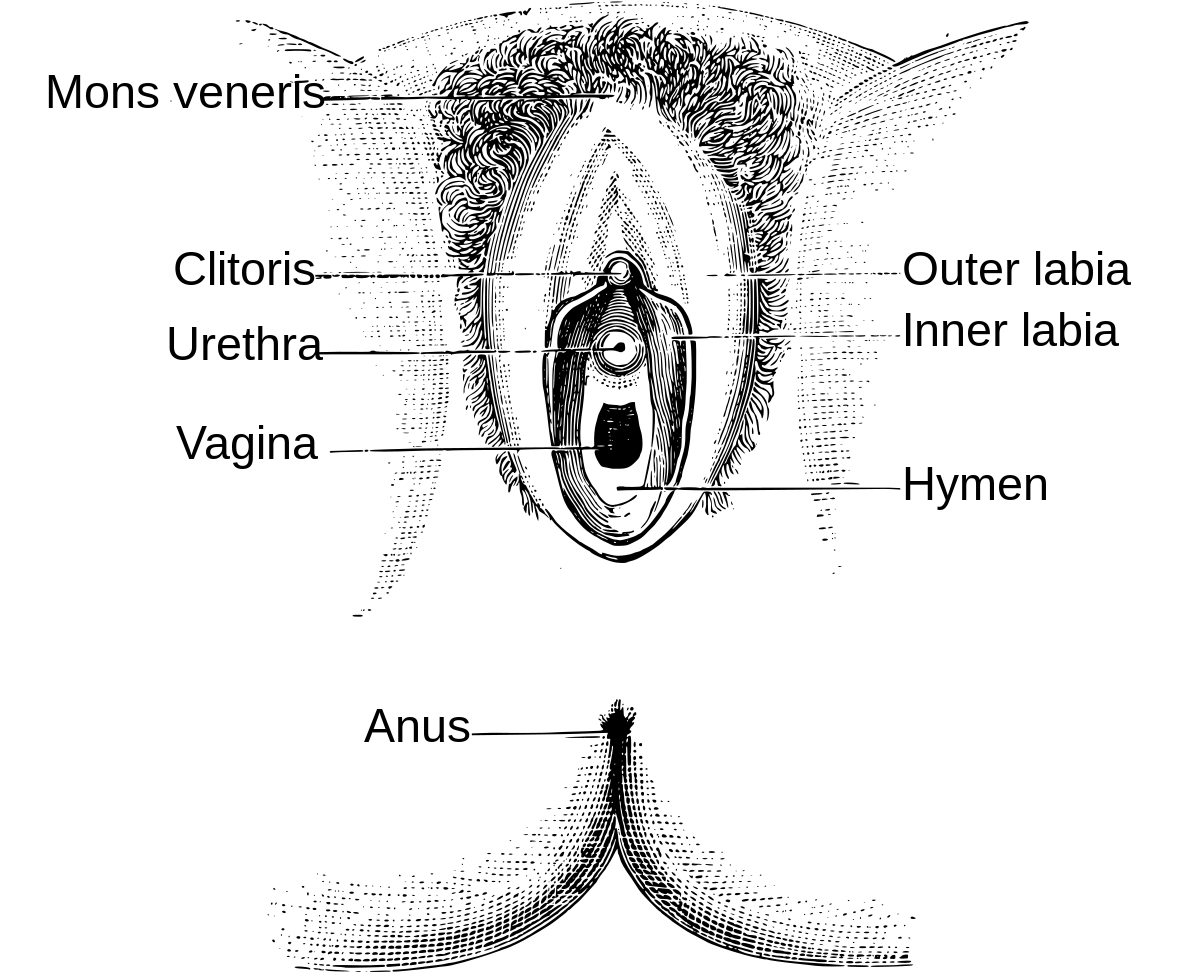The Female Hymn
What is it?
A common misconception about the hymen is that it is inside the vagina. It is a mucous membrane part of the vulva, the external genital organs…
…It is formed from a layer of tissue that develops in the early stages of fetal development when there is no opening in the vagina at all. This thin layer of tissue conceals the vagina but usually divides incompletely before birth, forming the hymen.
Sometimes this formation of an opening does not occur and results in a hymen that lacks the more common opening. Some females have no hymen at birth since the tissue is divided entirely in the womb. The size and shape of this opening (or openings) varies significantly from person to person.
The hymen is also not an indicator of virginity. The tissues of the vulva are generally fragile and delicate before puberty, so many girls and teens tear or dilate their hymen while participating in sports like bicycling, horseback riding, gymnastics, or while inserting tampons. A girl may not even know this has occurred since there may be little or no blood or pain involved when this happens. Remnants of the hymen are usually still present until a woman delivers a baby vaginally.
What does a hymn look like?
Similar to vulvas, it cannot be categorized into a one-size-fits-all category. Each hymn is unique in its shape, with some having a half-moon or ring shape and varying thicknesses. Just as with other body parts, the hymens differ among individuals. For most people, hymens do not fully seal the vaginal opening but instead have one or more holes through which menstrual blood, tampons, fingers, a penis, or sex toys can pass without necessarily disrupting the hymen.
An abnormal hymen in size and shape is uncommon but can occur in a few people. There are different hymen abnormalities, including cribriform, imperforate, microperforate, and septate hymens. Cribriform hymens have several small openings through which menstrual blood can flow, while an imperforate hymen completely covers the vaginal opening, leaving no opening at all. Micro-perforated hymens have a tiny space, and septate hymens have a thin band of tissue in the center, creating two separate vaginal openings. While pain or difficulties associated with these conditions are rare, hymen abnormalities can interfere with menstrual flow and tampon use. In such cases, a minor surgery called a hysterectomy can be performed by a gynecologist to remove the extra tissue and open up the hymen, allowing period blood to flow through.

How do you know if your hymen is still there?
Considering examining yourself for signs of hymen breakage, it is always a good idea to look closely at your anatomy. However, when it comes to the hymen, it is possible that you may not see much. The visibility of a person's hymen depends on the tissue's flexibility, thickness, and absence, which can vary from person to person and can change with age or hormonal shifts.
Our in-house sex expert emphasizes that even if it's not easy to find, chances are that if you were born with a hymen, you still have it in some capacity. Contrary to the misconception that the hymen disappears after penetration, it is a tissue formation that is part of the vagina. Therefore, it is not "broken" but instead may be stretched. Although the hymen may not be visible or look different, the tissue remains.
9 things to know about your hymen changing
A question we hear fairly often is whether fingering can break the hymen. While sexual activity such as fingering, oral sex, penetration, and masturbation can indeed cause the hymen to break, the truth is that the hymen can be broken in many other ways. Everyday activities such as inserting a tampon or engaging in exercise can also cause the hymen to tear. It is common for hymens to rupture during normal, day-to-day activities, and it is possible to break your hymen without even realizing it. Our sex expert explains that disrupting the hymen during weight-bearing exercise is possible without discomfort. This may be especially true if the hymen has already thinned due to aging or if there was not much tissue there. On the other hand, you may notice some bleeding and tenderness when your hymen tears, but this varies from person to person.
It's possible to engage in sexual activity and not break the hymen.
Participating in sexual activity does not guarantee that your hymen will break. The hymen can remain intact after fingering or oral sex, and it is possible (although rare) to have sexual intercourse without breaking the hymen. It is important to note that the presence or absence of a hymen does not indicate whether someone has engaged in sexual activity. This fact is worth repeating.
Some may question whether their hymen can return to its original state if sufficient time has elapsed since it was stretched or broken. However, this is not feasible. When a hymen is broken, naturally or through a hysterectomy, it cannot regenerate. And that's perfectly fine! As previously mentioned, it is not a necessary component of our anatomy.
Does it hurt when your hymen breaks?
Although some may have been informed that breaking the hymen will unquestionably result in pain, everyone's experience is unique. "Stretching or breaking the hymen can be painful, pleasurable, or a combination of the two, or it can go unnoticed," she stated. "The most crucial thing is to continue living your life and making choices that bring you joy."
What does it mean with regards to virginity?
"virginity" is a social construct rather than a medical one. People define it differently based on their upbringing, religion, or cultural beliefs. However, there is no scientific basis for the concept of virginity. The idea that virginity is lost only through heterosexual vaginal penetration is problematic and excludes many genders, sexualities, and sexual activities. This definition is heteronormative and does not account for people who engage in other forms of sexual activity. It's important to remember that having sex does not change your worth or value, and not having sex is also perfectly okay.

Masturbation may help if you are worried about pain.
We challenge the common belief that vaginal penetration is always painful and that pain during the first time is inevitable. She suggests that the discomfort felt during first-time penetrative sex is not solely due to the hymen but to the entire vaginal canal being stretched and changed in size. Anticipation of pain and discomfort can also trigger the brain to cause the pelvic muscles to respond in a way that increases pain. Therefore, it's essential to get familiar with your body through masturbation, as this can help you learn what feels good and what doesn't, making foreplay with a partner more pleasurable and relaxed. Ultimately, this can also lead to more comfortable and lubricated penetration when you're ready for it.